Abstract
Nine strains of Rochalimaea spp. that were isolated from patients over a period of 4.5 years were characterized for their enzyme activities, cellular fatty acid compositions, and DNA interrelatedness among Rochalimaea spp., Bartonella bacilliformis, and Afipia felis (cat scratch disease bacillus). All except one isolate, which was Rochalimaea quintana, were determined to belong to a newly proposed species, Rochalimaea henselae sp. nov. After recovery from clinical material, colonies required 5 to 15 days of incubation to become apparent. Cells were small, gram-negative, curved bacilli and displayed twitching motility. Enzyme specificities for amino acid and carbohydrate substrates showed that R. henselae could be distinguished from Rochalimaea vinsonii by L-arginyl-L-arginine and L-lysyl-L-alanine peptidases, but not all strains could be distinguished from R. quintana on the basis of peptidases or carbohydrate utilization. R. henselae also closely resembled R. quintana in cellular fatty acid composition, with both consisting mainly of C18:1, C18:0, and C16:0 fatty acids. However, the strains of R. henselae all contained C18:0 in amounts averaging greater than or equal to 22%, in contrast to R. quintana, which contained this cellular fatty acid in amounts averaging 16 and 18%. DNA hybridization confirmed the identification of one clinical isolate as R. quintana and showed a close interrelatedness (92 to 100%) among the other strains. Under optimal conditions for DNA reassociation, R. henselae showed approximately 70% relatedness to R. quintana and approximately 60% relatedness to R. vinsonii. Relatedness with DNA from B. baciliformis was 43%. R. henselae was unrelated to A. felis. R. henselae is the proposed species of a newly recognized member of the family Rickettsiaceae, which is a pathogen that may be encountered in immunocompromised or immunocompetent patients. Prolonged fever with bacteremia or vascular proliferative lesions are clinical manifestations of the agent.
Full text
PDF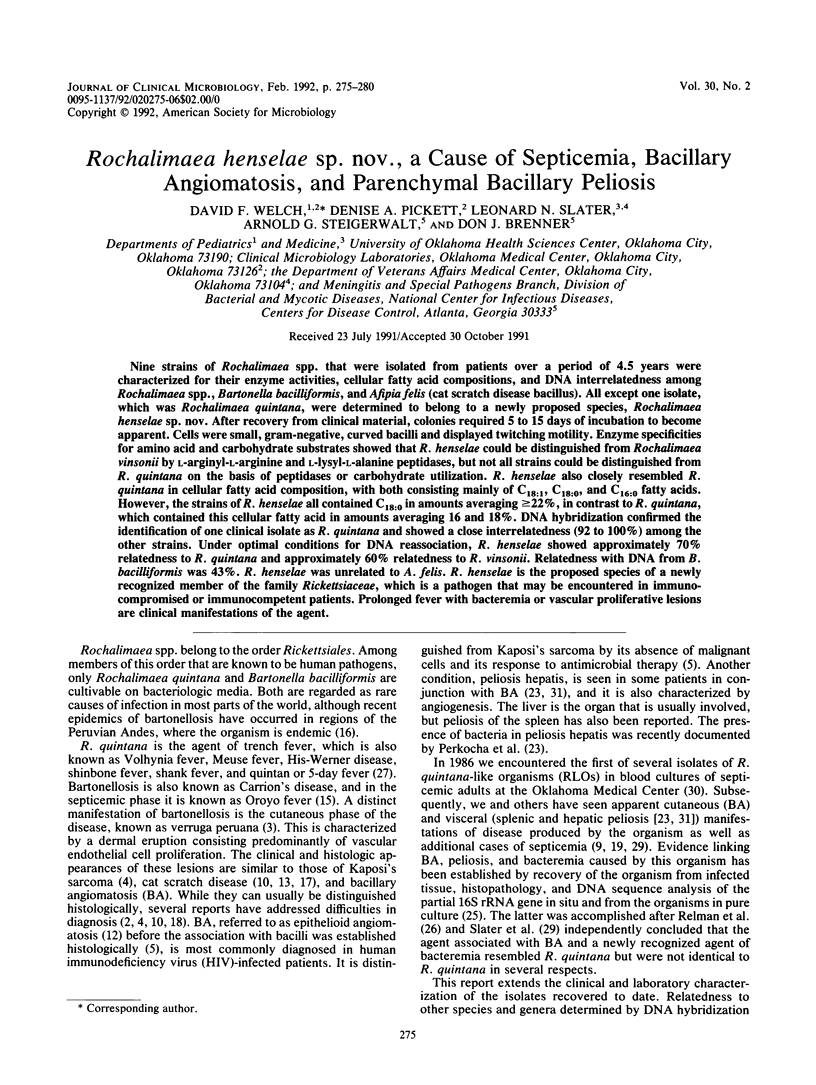
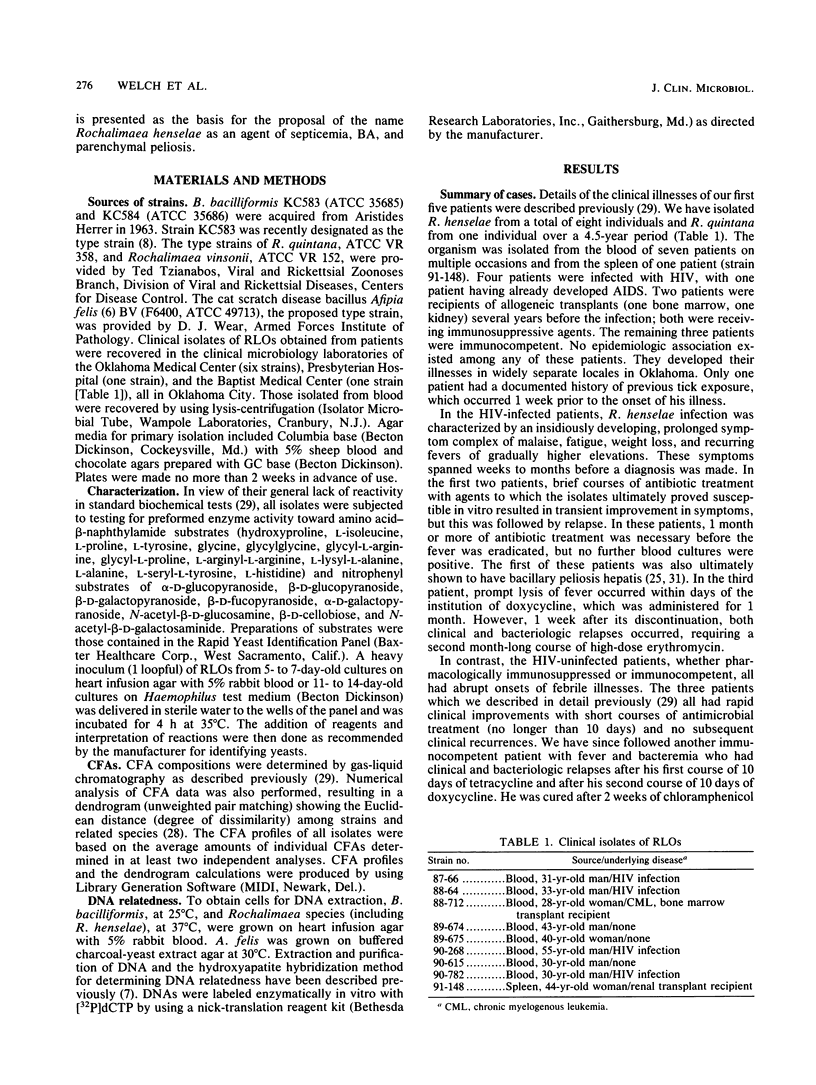
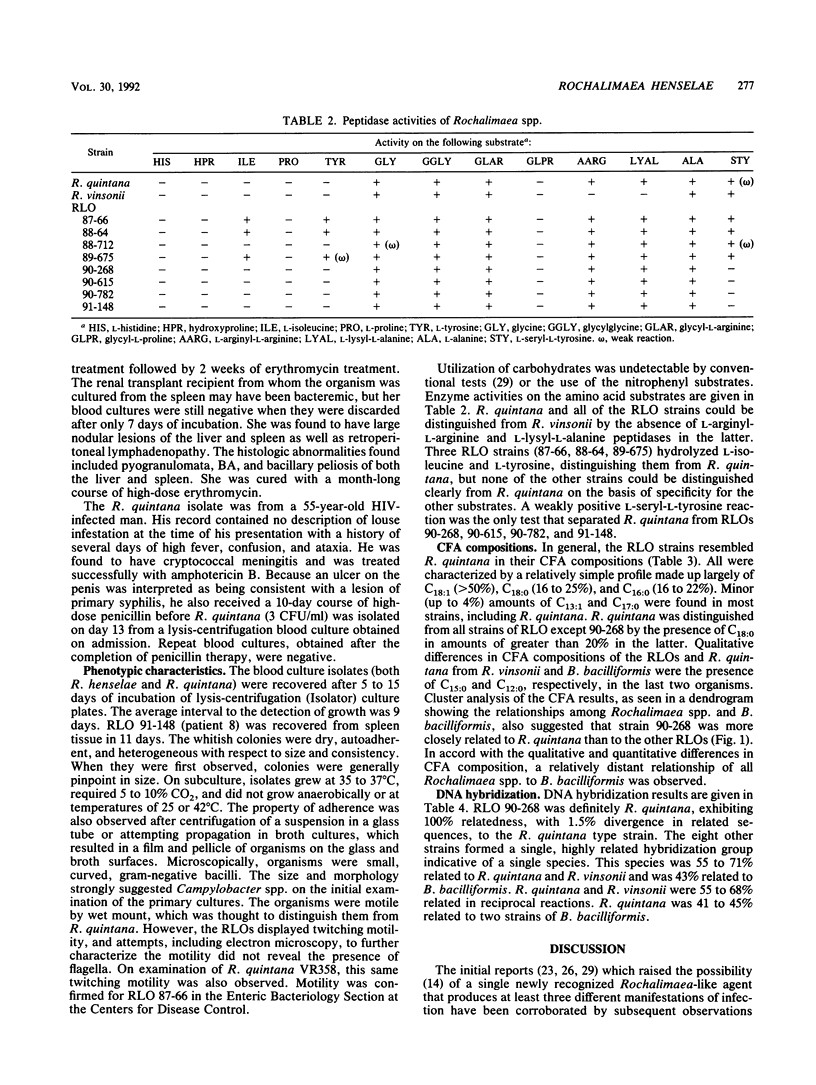
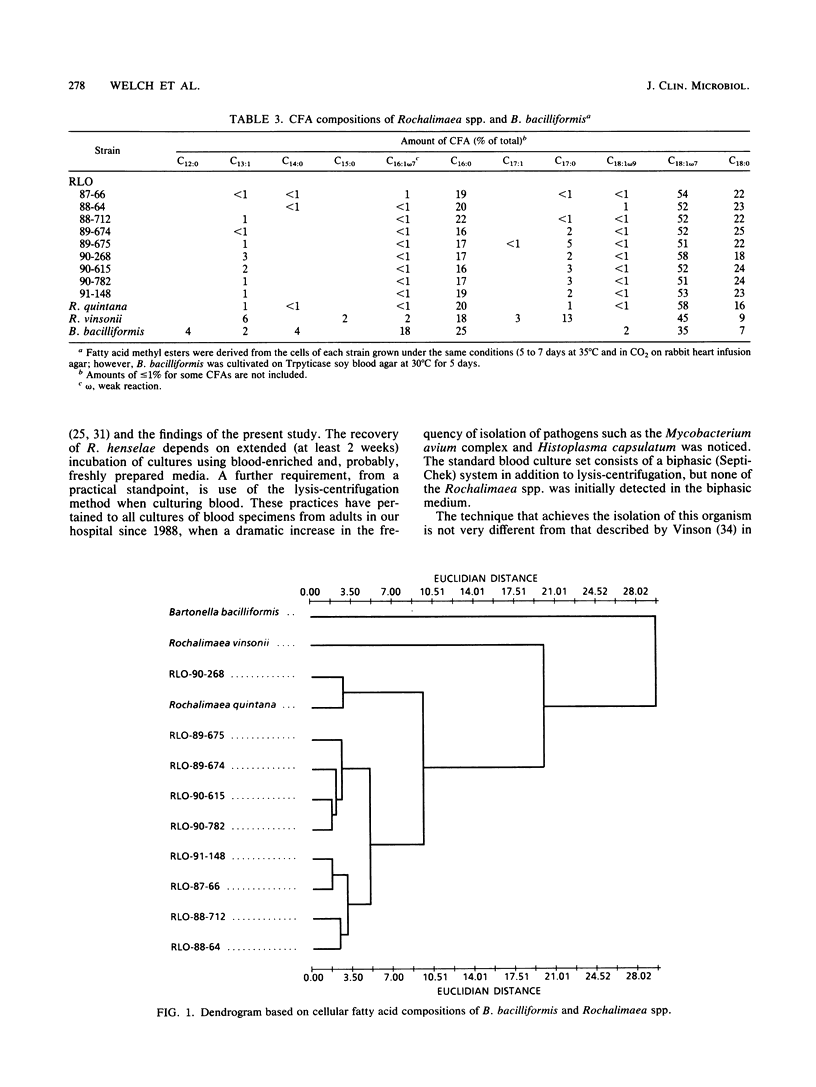
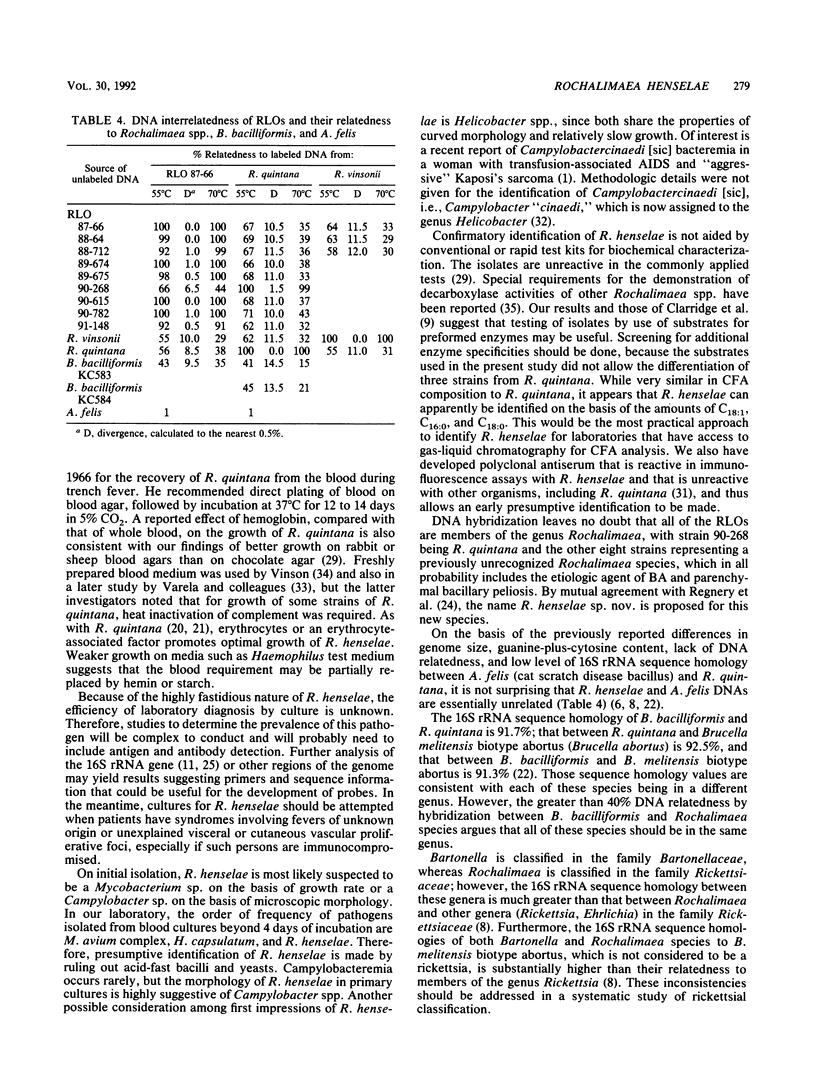
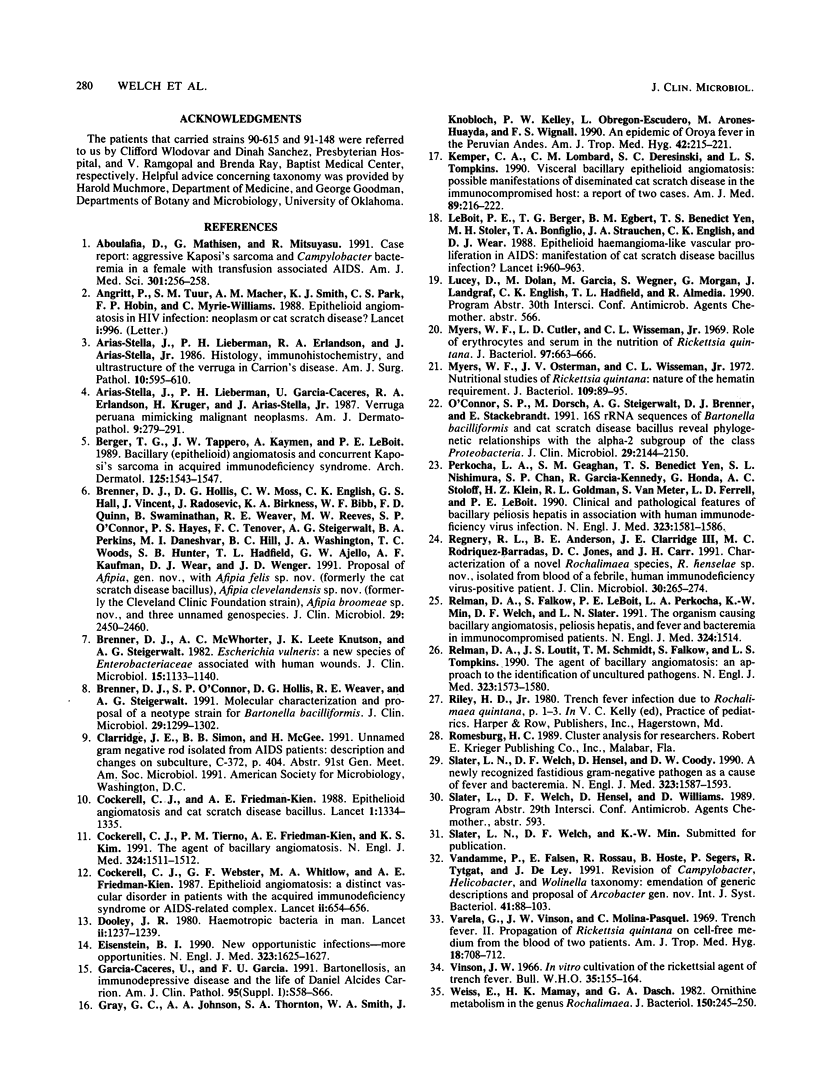
Selected References
These references are in PubMed. This may not be the complete list of references from this article.
- Aboulafia D., Mathisen G., Mitsuyasu R. Aggressive Kaposi's sarcoma and campylobacter bacteremia in a female with transfusion associated AIDS. Am J Med Sci. 1991 Apr;301(4):256–258. doi: 10.1097/00000441-199104000-00005. [DOI] [PubMed] [Google Scholar]
- Angritt P., Tuur S. M., Macher A. M., Smith K. J., Park C. S., Hobin F. P., Myrie-Williams C. Epithelioid angiomatosis in HIV infection: neoplasm or cat-scratch disease? Lancet. 1988 Apr 30;1(8592):996–996. doi: 10.1016/s0140-6736(88)91813-2. [DOI] [PubMed] [Google Scholar]
- Arias-Stella J., Lieberman P. H., Erlandson R. A., Arias-Stella J., Jr Histology, immunohistochemistry, and ultrastructure of the verruga in Carrion's disease. Am J Surg Pathol. 1986 Sep;10(9):595–610. doi: 10.1097/00000478-198609000-00002. [DOI] [PubMed] [Google Scholar]
- Arias-Stella J., Lieberman P. H., Garcia-Caceres U., Erlandson R. A., Kruger H., Arias-Stella J., Jr Verruga peruana mimicking malignant neoplasms. Am J Dermatopathol. 1987 Aug;9(4):279–291. doi: 10.1097/00000372-198708000-00001. [DOI] [PubMed] [Google Scholar]
- Berger T. G., Tappero J. W., Kaymen A., LeBoit P. E. Bacillary (epithelioid) angiomatosis and concurrent Kaposi's sarcoma in acquired immunodeficiency syndrome. Arch Dermatol. 1989 Nov;125(11):1543–1547. [PubMed] [Google Scholar]
- Brenner D. J., Hollis D. G., Moss C. W., English C. K., Hall G. S., Vincent J., Radosevic J., Birkness K. A., Bibb W. F., Quinn F. D. Proposal of Afipia gen. nov., with Afipia felis sp. nov. (formerly the cat scratch disease bacillus), Afipia clevelandensis sp. nov. (formerly the Cleveland Clinic Foundation strain), Afipia broomeae sp. nov., and three unnamed genospecies. J Clin Microbiol. 1991 Nov;29(11):2450–2460. doi: 10.1128/jcm.29.11.2450-2460.1991. [DOI] [PMC free article] [PubMed] [Google Scholar]
- Brenner D. J., McWhorter A. C., Knutson J. K., Steigerwalt A. G. Escherichia vulneris: a new species of Enterobacteriaceae associated with human wounds. J Clin Microbiol. 1982 Jun;15(6):1133–1140. doi: 10.1128/jcm.15.6.1133-1140.1982. [DOI] [PMC free article] [PubMed] [Google Scholar]
- Brenner D. J., O'Connor S. P., Hollis D. G., Weaver R. E., Steigerwalt A. G. Molecular characterization and proposal of a neotype strain for Bartonella bacilliformis. J Clin Microbiol. 1991 Jul;29(7):1299–1302. doi: 10.1128/jcm.29.7.1299-1302.1991. [DOI] [PMC free article] [PubMed] [Google Scholar]
- Cockerell C. J., Friedman-Kien A. E. Epithelioid angiomatosis and cat scratch disease bacillus. Lancet. 1988 Jun 11;1(8598):1334–1335. doi: 10.1016/s0140-6736(88)92146-0. [DOI] [PubMed] [Google Scholar]
- Cockerell C. J., Whitlow M. A., Webster G. F., Friedman-Kien A. E. Epithelioid angiomatosis: a distinct vascular disorder in patients with the acquired immunodeficiency syndrome or AIDS-related complex. Lancet. 1987 Sep 19;2(8560):654–656. doi: 10.1016/s0140-6736(87)92442-1. [DOI] [PubMed] [Google Scholar]
- Dooley J. R. Haemotropic bacteria in man. Lancet. 1980 Dec 6;2(8206):1237–1239. doi: 10.1016/s0140-6736(80)92490-3. [DOI] [PubMed] [Google Scholar]
- Eisenstein B. I. New opportunistic infections--more opportunities. N Engl J Med. 1990 Dec 6;323(23):1625–1627. doi: 10.1056/NEJM199012063232309. [DOI] [PubMed] [Google Scholar]
- Garcia-Caceres U., Garcia F. U. Bartonellosis. An immunodepressive disease and the life of Daniel Alcides Carrión. Am J Clin Pathol. 1991 Apr;95(4 Suppl 1):S58–S66. [PubMed] [Google Scholar]
- Gray G. C., Johnson A. A., Thornton S. A., Smith W. A., Knobloch J., Kelley P. W., Obregon Escudero L., Arones Huayda M., Wignall F. S. An epidemic of Oroya fever in the Peruvian Andes. Am J Trop Med Hyg. 1990 Mar;42(3):215–221. doi: 10.4269/ajtmh.1990.42.215. [DOI] [PubMed] [Google Scholar]
- Kemper C. A., Lombard C. M., Deresinski S. C., Tompkins L. S. Visceral bacillary epithelioid angiomatosis: possible manifestations of disseminated cat scratch disease in the immunocompromised host: a report of two cases. Am J Med. 1990 Aug;89(2):216–222. doi: 10.1016/0002-9343(90)90301-s. [DOI] [PubMed] [Google Scholar]
- LeBoit P. E., Berger T. G., Egbert B. M., Yen T. S., Stoler M. H., Bonfiglio T. A., Strauchen J. A., English C. K., Wear D. J. Epithelioid haemangioma-like vascular proliferation in AIDS: manifestation of cat scratch disease bacillus infection? Lancet. 1988 Apr 30;1(8592):960–963. doi: 10.1016/s0140-6736(88)91779-5. [DOI] [PubMed] [Google Scholar]
- Myers W. F., Cutler L. D., Wisseman C. L., Jr Role of erythrocytes and serum in the nutrition of Rickettsia quintana. J Bacteriol. 1969 Feb;97(2):663–666. doi: 10.1128/jb.97.2.663-666.1969. [DOI] [PMC free article] [PubMed] [Google Scholar]
- Myers W. F., Osterman J. V., Wisseman C. L., Jr Nutritional studies of Rickettsia guintana: nature of the hematin requirement. J Bacteriol. 1972 Jan;109(1):89–95. doi: 10.1128/jb.109.1.89-95.1972. [DOI] [PMC free article] [PubMed] [Google Scholar]
- O'Connor S. P., Dorsch M., Steigerwalt A. G., Brenner D. J., Stackebrandt E. 16S rRNA sequences of Bartonella bacilliformis and cat scratch disease bacillus reveal phylogenetic relationships with the alpha-2 subgroup of the class Proteobacteria. J Clin Microbiol. 1991 Oct;29(10):2144–2150. doi: 10.1128/jcm.29.10.2144-2150.1991. [DOI] [PMC free article] [PubMed] [Google Scholar]
- Perkocha L. A., Geaghan S. M., Yen T. S., Nishimura S. L., Chan S. P., Garcia-Kennedy R., Honda G., Stoloff A. C., Klein H. Z., Goldman R. L. Clinical and pathological features of bacillary peliosis hepatis in association with human immunodeficiency virus infection. N Engl J Med. 1990 Dec 6;323(23):1581–1586. doi: 10.1056/NEJM199012063232302. [DOI] [PubMed] [Google Scholar]
- Regnery R. L., Anderson B. E., Clarridge J. E., 3rd, Rodriguez-Barradas M. C., Jones D. C., Carr J. H. Characterization of a novel Rochalimaea species, R. henselae sp. nov., isolated from blood of a febrile, human immunodeficiency virus-positive patient. J Clin Microbiol. 1992 Feb;30(2):265–274. doi: 10.1128/jcm.30.2.265-274.1992. [DOI] [PMC free article] [PubMed] [Google Scholar]
- Relman D. A., Falkow S., LeBoit P. E., Perkocha L. A., Min K. W., Welch D. F., Slater L. N. The organism causing bacillary angiomatosis, peliosis hepatis, and fever and bacteremia in immunocompromised patients. N Engl J Med. 1991 May 23;324(21):1514–1514. doi: 10.1056/NEJM199105233242117. [DOI] [PubMed] [Google Scholar]
- Relman D. A., Loutit J. S., Schmidt T. M., Falkow S., Tompkins L. S. The agent of bacillary angiomatosis. An approach to the identification of uncultured pathogens. N Engl J Med. 1990 Dec 6;323(23):1573–1580. doi: 10.1056/NEJM199012063232301. [DOI] [PubMed] [Google Scholar]
- Slater L. N., Welch D. F., Hensel D., Coody D. W. A newly recognized fastidious gram-negative pathogen as a cause of fever and bacteremia. N Engl J Med. 1990 Dec 6;323(23):1587–1593. doi: 10.1056/NEJM199012063232303. [DOI] [PubMed] [Google Scholar]
- The agent of bacillary angiomatosis. N Engl J Med. 1991 May 23;324(21):1511–1513. doi: 10.1056/NEJM199105233242115. [DOI] [PubMed] [Google Scholar]
- Vandamme P., Falsen E., Rossau R., Hoste B., Segers P., Tytgat R., De Ley J. Revision of Campylobacter, Helicobacter, and Wolinella taxonomy: emendation of generic descriptions and proposal of Arcobacter gen. nov. Int J Syst Bacteriol. 1991 Jan;41(1):88–103. doi: 10.1099/00207713-41-1-88. [DOI] [PubMed] [Google Scholar]
- Varela G., Vinson J. W., Molina-Pasquel C. Trench fever. II. Propagation of Rickettsia quintana on cell-free medium from the blood of two patients. Am J Trop Med Hyg. 1969 Sep;18(5):708–712. [PubMed] [Google Scholar]
- Vinson J. W. In vitro cultivation of the rickettsial agent of trench fever. Bull World Health Organ. 1966;35(2):155–164. [PMC free article] [PubMed] [Google Scholar]
- Weiss E., Mamay H. K., Dasch G. A. Ornithine metabolism in the genus Rochalimaea. J Bacteriol. 1982 Apr;150(1):245–250. doi: 10.1128/jb.150.1.245-250.1982. [DOI] [PMC free article] [PubMed] [Google Scholar]


